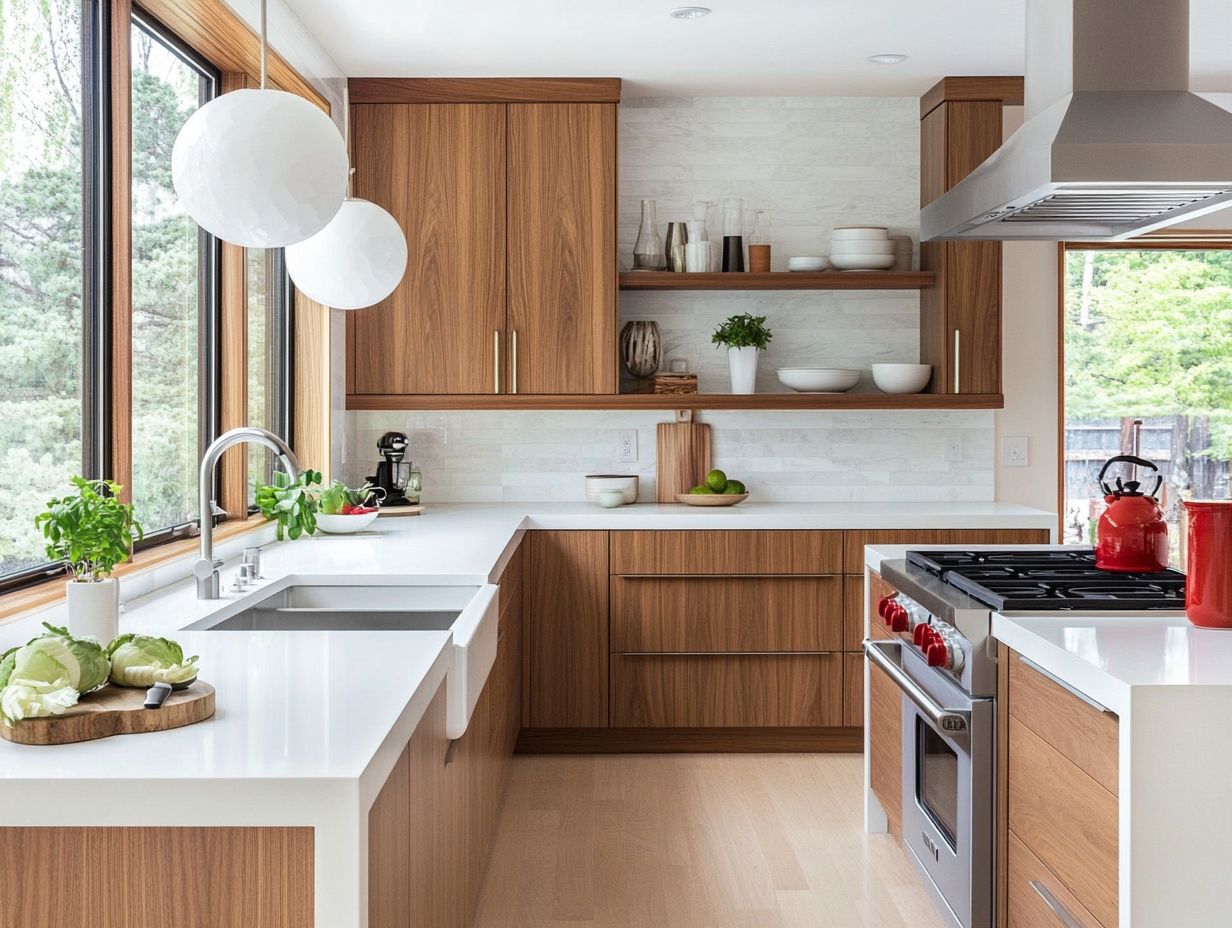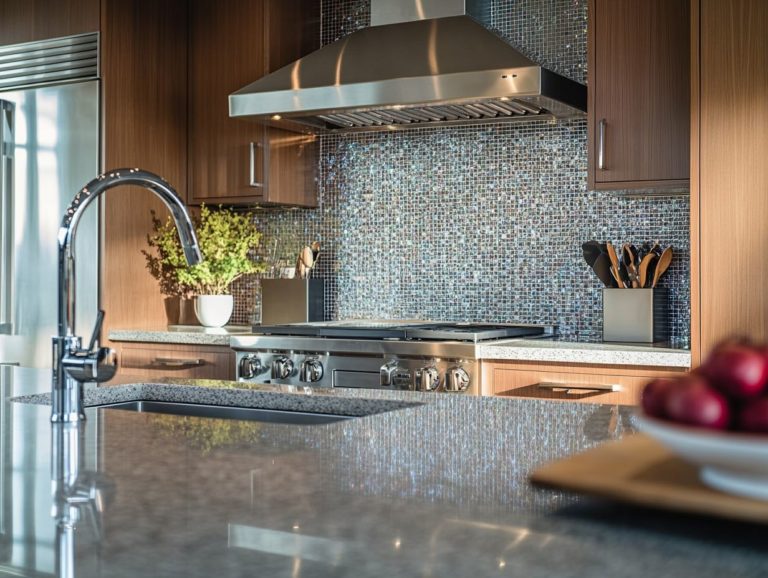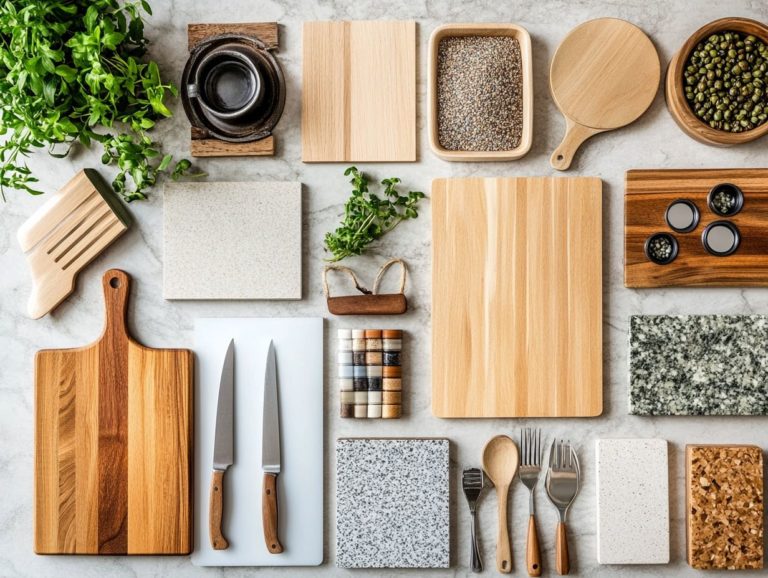Comparing Wood vs. Laminate Cabinets in Kitchen Design
Selecting the ideal cabinets can truly elevate your kitchen, striking a harmonious balance between style and functionality.
This article delves into the advantages and disadvantages of wood and laminate cabinets—two popular choices that each offer distinct benefits and challenges for your space.
From the enduring elegance of wood to the contemporary versatility of laminate, we’ll dissect their merits and drawbacks. We will consider essential factors such as cost, durability, how it looks, and maintenance.
Uncover which material resonates most with your vision!
Contents
- Key Takeaways:
- The Importance of Choosing the Right Material
- Wood Cabinets: Pros and Cons
- Laminate Cabinets: Pros and Cons
- Factors to Consider When Choosing Between Wood and Laminate Cabinets
- Durability
- Aesthetics
- Maintenance and Cleaning
- Frequently Asked Questions
- What are the main differences between wood and laminate cabinets in kitchen design?
- Which option is more durable, wood or laminate cabinets?
- What are the cost differences between wood and laminate cabinets?
- Do wood or laminate cabinets require more maintenance?
- Which type of cabinet is better for a modern kitchen design?
- Are there any environmental considerations when choosing between wood and laminate cabinets?
Key Takeaways:

Wood cabinets: offer a classic and natural look, but require more maintenance and are more expensive than laminate options.
Laminate cabinets: are budget-friendly and easy to maintain, but may not have the same level of durability and aesthetic appeal as wood.
When choosing between wood and laminate cabinets: consider factors such as cost, durability, how it looks, and maintenance needs to make the best decision for your kitchen design.
The Importance of Choosing the Right Material
Choosing the right material for your kitchen cabinets is essential to achieving the perfect blend of aesthetic appeal and functionality in your remodel.
As a homeowner, you often find yourself weighing the benefits of wood cabinets against those of laminate cabinets. Each option presents unique advantages and drawbacks.
It’s vital to grasp the nuances of these materials. They shape the visual impact of your kitchen and affect long-term durability, maintenance needs, and overall investment value.
With customization options becoming increasingly popular, having a clear understanding of the strengths and weaknesses of each choice can elevate your home improvement project to new heights.
Wood Cabinets: Pros and Cons
Wood cabinets are a popular choice for discerning homeowners, celebrated for their natural beauty and timeless allure. Weigh the pros and cons carefully.
Various wood types—like oak, maple, cherry, and walnut—bring distinct grain patterns and durability to the table, enhancing the kitchen’s overall aesthetic.
However, you must consider factors such as moisture resistance, which is the ability of a material to withstand water. Maintenance needs can significantly influence the cabinets’ longevity and visual appeal over the years.
Benefits of Wood Cabinets
Wood cabinets bring a wealth of benefits that make them the go-to choice for homeowners eager to elevate their kitchen aesthetics. With exceptional durability and a host of customization options, they truly stand out.
These cabinets offer unique aesthetic appeal, effortlessly blending with various design styles—from contemporary to rustic.
You’ll find an extensive selection of wood species, such as oak, maple, and cherry, each imparting its own distinctive character and charm to your space.
The ability to stain, paint, or leave the wood in its natural state adds a personal touch, allowing you to craft designs that reflect your individual taste.
Quality wood’s inherent strength and resilience set it apart from other materials. This ensures that your cabinets remain not just functional but also stunning for years to come, infusing your kitchen with an air of sophistication and enhancing its overall atmosphere.
Drawbacks of Wood Cabinets
While wood cabinets undeniably radiate charm, consider the notable drawbacks carefully!
The maintenance can be quite demanding. Regular cleaning and occasional refinishing are needed to maintain their natural beauty and durability.
Wood can warp or mold if it gets wet. Consider moisture-proof options to enhance longevity.
This vulnerability can compromise your kitchen’s functionality, resulting in doors that stick or fail to close properly. Repairing such damage can be costly and time-consuming, often requiring specialized knowledge or professional help.
The aesthetic appeal of wood cabinets may also fade over time if not properly cared for, with scratches and stains becoming increasingly apparent.
As a homeowner, you might find yourself balancing the allure of these cabinets against the practical inconveniences they may bring into your daily life.
Laminate Cabinets: Pros and Cons

Laminate cabinets are popular among homeowners seeking cost-effective kitchen remodels. They offer a practical alternative to traditional wood cabinetry without compromising style.
These cabinets are crafted from synthetic materials. They come in various laminate types and finishes, allowing you to design your kitchen while maintaining look and feel.
It’s essential to explore how long laminate and wood cabinets last. This comparison reveals advantages and disadvantages that could impact your long-term satisfaction with your choice.
Benefits of Laminate Cabinets
Laminate cabinets offer many advantages that are particularly appealing for budget-savvy homeowners. They desire both style and functionality in their kitchen remodels.
With finishes that beautifully mimic traditional wood, these cabinets provide excellent scratch and moisture resistance. This makes them ideal for busy, high-traffic areas.
Not only do these cabinets enhance your kitchen’s aesthetics cost-effectively, but they also come in an array of styles, colors, and textures to match any design preference.
This versatility allows for effortless integration into various interior themes. Whether you prefer modern chic or classic rustic, their durability ensures they can handle everyday wear and tear.
By opting for laminate, you can create a beautifully organized kitchen that retains its charm over time, elevating both functionality and visual appeal.
Drawbacks of Laminate Cabinets
Despite their benefits, laminate cabinets have drawbacks that may make you reconsider your choice for your kitchen remodel.
One significant concern is their durability compared to traditional wood cabinets. Laminate surfaces may not withstand wear and tear as well, leading to weaknesses over time.
While laminate can be visually appealing, it often lacks the natural beauty and unique grain patterns of wood. This can make laminate cabinets feel less refined, limiting their ability to create that warm, inviting atmosphere in your home.
These cabinets can chip, scratch, and sustain moisture damage more easily, which could mean costly repairs or replacements in the future.
When homeowners prioritize longevity and overall appearance, these durability concerns often lead them to consider alternative materials that offer both resilience and style.
Factors to Consider When Choosing Between Wood and Laminate Cabinets
When choosing between wood and laminate cabinets for your kitchen remodel, several critical factors need your attention. These elements ensure you make the best investment for your home.
Cost is often a primary consideration, as laminate cabinets generally provide more budget-friendly options than wooden ones. However, durability, maintenance needs, and overall look are equally important.
Take the time to weigh these factors carefully, and you’ll find the option that suits both your budget and your vision for your space.
Cost
Cost is undoubtedly a primary consideration for homeowners navigating the decision between wood and laminate cabinets. Your budget significantly shapes the entire home improvement project.
While laminate cabinets often emerge as the more cost-effective choice, wood cabinets can elevate your home’s long-term value. It’s essential to weigh both the initial investment and future return.
Laminate cabinets typically cost much less than their wooden counterparts, making them appealing for budget-conscious renovations. However, investing in wood could yield a higher resale value, as many buyers are drawn to the aesthetic charm and durability of solid wood.
Keep in mind that maintenance and longevity will impact your total expenses. Laminate may need replacing sooner than wood. Ultimately, it’s crucial to assess these financial implications while striving to enhance your property’s appeal within your budget constraints.
Durability

When choosing between wood and laminate cabinets, durability is a key factor to assess. It influences both maintenance requirements and the longevity of your cabinetry.
Wood cabinets are often very durable with proper care, but they require more upkeep than laminate counterparts, which are easier to clean and more resistant to wear.
Wood cabinets can endure for decades, but you’ll need to regularly polish and seal them to protect against scratches and moisture damage.
In contrast, laminate cabinets resist stains and scratches, making them ideal for busy kitchens. A simple wipe down with a damp cloth is usually all they need, with minimal refinishing over time.
As you weigh your options, don’t just consider the upfront costs—think about the long-term benefits each choice involves.
Aesthetics
Aesthetics play a pivotal role in your decision-making process, significantly influencing your kitchen design. The visual appeal of wood cabinets versus laminate cabinets is a key consideration.
Wood cabinets are praised for their unique designs and inherent beauty, while laminate can mimic various styles but may lack the authentic charm of real wood.
The warmth and richness of hardwood create a timeless atmosphere, making your kitchen more inviting and luxurious. On the flip side, laminate offers a variety of colors and finishes, giving you flexibility to cater to modern tastes.
You’ll appreciate how customizable the finishes of both options can be—ranging from matte to high gloss—impacting style and practical elements like maintenance and organization.
Ultimately, the choice between wood and laminate reflects your personal preferences and vision for your culinary space.
Maintenance and Cleaning
When choosing between wood and laminate cabinets, maintenance and cleaning should be top of mind, as these factors influence the longevity and appearance of your cabinetry.
Laminate cabinets typically demand less upkeep, making them ideal for busy households. In contrast, wood cabinets may require periodic refinishing and careful cleaning to maintain their timeless aesthetic.
For cooking enthusiasts, the convenience of wiping down laminate surfaces with mild soap and water simplifies your kitchen routine.
If you choose wood cabinets, you’ll find yourself regularly dusting and occasionally polishing to keep their natural luster intact.
Repair considerations also come into play. Laminate can be easily replaced or patched, while wood repairs often involve sanding and staining, requiring a hands-on approach.
Understanding these maintenance nuances empowers you to make informed decisions that align with your lifestyle, ensuring your kitchen remains a stunning focal point in your home.
Frequently Asked Questions
What are the main differences between wood and laminate cabinets in kitchen design?
The main differences between wood and laminate cabinets are the materials used and the overall look and feel. Wood cabinets are made from natural wood, which gives them a classic look, while laminate cabinets are made from synthetic materials and can mimic various textures and finishes.
Which option is more durable, wood or laminate cabinets?

Both wood and laminate cabinets can be durable options for kitchen design. Wood cabinets are typically more resistant to scratches and dings, while laminate cabinets are less likely to warp or fade over time. Ultimately, the durability of each option depends on the specific materials and quality of construction.
What are the cost differences between wood and laminate cabinets?
Laminate cabinets are generally less expensive than wood cabinets. Laminate is a synthetic material, making it affordable and easy to produce.
Wood cabinets vary greatly in price. It depends on the type of wood and the level of customization.
Do wood or laminate cabinets require more maintenance?
Wood cabinets often need more upkeep. Regular cleaning and occasional polishing or refinishing are needed.
Laminate cabinets are low maintenance. They can be easily cleaned with mild soap and water.
Which type of cabinet is better for a modern kitchen design?
Laminate cabinets are a fantastic choice for modern kitchens! They offer a sleek and customizable look.
Wood cabinets can also fit in modern designs. It depends on the wood type and finish chosen.
Are there any environmental considerations when choosing between wood and laminate cabinets?
Both wood and laminate cabinets can be eco-friendly. Wood is usually more sustainable since it comes from a renewable resource.
Some laminate cabinets are made from recycled materials. Don’t forget to check the materials for sustainability – it’s important!





